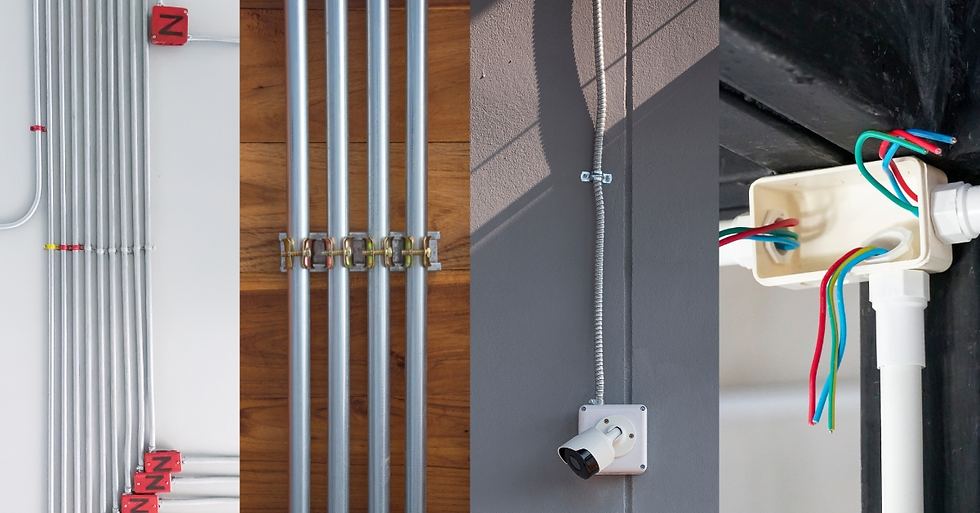Electrical Wiring for Kitchen, Bathroom & Outdoor Areas – What’s Required?
- Epul Naim

- May 5
- 3 min read
Updated: May 8
Index:
Introduction ⚡🚿🍳🌳
Planning an electrical upgrade or renovation in your home? The kitchen, bathroom, and outdoor areas are the three most demanding zones when it comes to wiring — and for good reason. These spaces combine water, heat, and heavy electrical loads, making safety and proper design critical. Here’s what Malaysian homeowners need to know to stay safe and compliant.
Why These Areas Need Special Wiring Considerations
Bathrooms, kitchens, and outdoor spaces pose higher risks of electrical shock or fire due to:
High moisture and humidity levels
Use of high-wattage appliances
Exposure to weather (in outdoor setups)
Improper wiring in these areas can lead to short circuits, electrocution, or insurance claim issues.
Kitchen Electrical Wiring Requirements 🍽️
The kitchen is one of the most power-intensive spaces in your home. Here's what to consider:
1. Dedicated Circuits for Major Appliances
Oven, microwave, fridge, and dishwasher should each have their own circuit.
Use 13A sockets with MCB (Miniature Circuit Breaker) protection.
2. RCD/ELCB Protection
A Residual Current Device (RCD) is crucial to protect against electric shocks near water sources.
3. Heat-Resistant Cabling
Wires near ovens or cooktops should be heat-resistant and installed with proper insulation sleeves.
4. Sufficient Power Points
Ensure there are enough outlets above countertop level to avoid overloading extension cords.
5. Appliance Placement Planning
Plan your wiring layout according to where appliances are located to reduce unnecessary extensions and ensure proper load distribution.
6. Under-Cabinet & Task Lighting
Use low-voltage lighting with concealed wiring that’s moisture- and heat-resistant for safer cooking spaces.
Bathroom Electrical Wiring Requirements 🚿
Electrical fittings in bathrooms must adhere to wet area safety standards:
1. Waterproof & IP-Rated Fixtures
Lights, fans, and water heaters must be IP44 or above (splashproof).
2. Water Heater Circuit
Use a dedicated 20A switch with an isolator installed outside the bathroom.
3. No Power Sockets Inside (Unless RCD-Protected)
Avoid installing sockets unless absolutely necessary — and only if protected by RCDs.
4. Bonding & Earthing
Proper grounding and bonding reduce the risk of shock. Make sure the contractor checks continuity.
5. Shaver Sockets & Mirrors with Lights
If needed, use IP-rated, built-in shaver sockets or mirrors with pre-fitted, safe LED lighting.
6. Zoning Compliance
Understand bathroom "zones" (Zone 0, 1, 2) and ensure electrical items are installed in the correct zone with the right IP rating.
Outdoor Electrical Wiring Requirements 🌧️🌴
Outdoor areas are fully exposed to weather, making weatherproofing and durability key:
1. Use of Armoured or Conduit Cabling
Install wires in steel conduit or armoured cable for added protection against weather and physical damage.
2. IP65 or Higher Rated Fixtures
Light fittings and sockets should be at least IP65 for rain protection.
3. Elevated Installation
Avoid placing power points or light switches near the ground to prevent water exposure.
4. Timers and Motion Sensors
Consider smart outdoor lighting to save energy and enhance safety.
5. Outdoor Ceiling Fans or Water Features
Use weatherproof fan regulators and ensure all connections are sealed and protected.
6. Garden & Landscape Lighting
Use low-voltage outdoor systems with waterproof transformers for ambient and decorative lighting.
Did You Know? 🔌
According to Suruhanjaya Tenaga Malaysia, the most common causes of residential electrical fires are overloaded circuits and poor installation practices—often in wet zones like bathrooms and kitchens.
Source: Energy Commission Malaysia
Conclusion
Wiring your kitchen, bathroom, and outdoor spaces safely isn’t just about convenience—it’s about protecting your home and family. Always hire a licensed electrician, follow IP and RCD standards, and plan for the right power load to avoid hazards. These areas require more than basic wiring—they demand expert attention.
FAQs 🧠
1. Can I use regular indoor wires for outdoor installations?
No. Outdoor wiring must be weatherproof, using conduits or armoured cables with IP-rated fittings.
2. What does IP rating mean?
IP (Ingress Protection) ratings show how resistant a device is to dust and water. For wet areas, aim for IP44–IP65.
3. Is it safe to install power sockets in bathrooms?
Generally not recommended unless RCD-protected and placed away from water sources.
4. Do kitchen appliances need their own circuit?
Yes. High-power appliances like ovens and fridges require dedicated circuits to prevent overloads.
5. Who should I hire for this type of work?
Only hire Suruhanjaya Tenaga-certified electricians for residential wiring to meet safety and legal standards.
Need a Certified Electrician for Kitchen or Outdoor Wiring?
Ensure safe installations that meet Malaysian standards. Book a licensed contractor today at WiringRumah⚡🔧






Comments